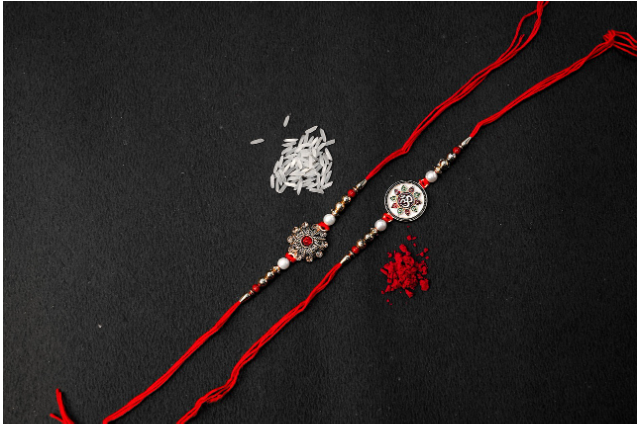
Raksha Bandhan is not just a festival but a reminder of love, trust, and the special bond between siblings. This beautiful festival falls on the full moon day of Shravana Purnima every year, when sisters tie a rakhi (sacred thread) on their brothers’ wrists, wishing for their good luck and safety. The brothers, in return, promise to protect and take care of their sisters. The beauty of this festival is that the thread acts as physical evidence of the bond, which runs deep in the heart, full of care, honour, and emotional strength.
The name Raksha Bandhan comes from two Sanskrit words: ‘Raksha’ meaning ‘protection’ and ‘Bandhan’ meaning ‘connection.’ This festival has been celebrated for centuries across India—and it wasn’t and isn’t limited to siblings bound by blood! The rakhi is tied to friends, Gods, and even to people of different religions! Even brothers sometimes tie rakhis to their sisters, praying for their well-being and safety. There’s no boundary, physical or imaginary, that can stop love from spreading!
Even as we embrace modernity and siblings live far away from each other, Raksha Bandhan is growing in value. Whether it be a handmade rakhi or a digital one, whether it be an ordinary thread or one with Chhota Bheem on it, the love and prayer behind it make it extraordinary. To have someone wishing for your safety in this increasingly divided world is a feeling worth living for.
Spiritual Essence and Vedic Significance
The full moon is seen as a symbol of purity, completeness, and emotional clarity. Hence, the day was chosen for this auspicious event. In ancient times, this thread was not just a decoration used for flexing your sibling status. It was a necessary ritual before students began working on their careers, before warriors went to the battlefield, and before loved ones parted ways. It was a silent promise that they would come back safely and successfully.
The rakhi isn’t a thread just tied to the wrist but to the soul. It’s like saying, ‘Hey sibling, I am rooting for you!’ And it can be tied to anyone whose presence gives you strength and support. In earlier times, when there were no phones to communicate with and letters were rarely written, just looking at the rakhi made the bearer feel the presence of their loved ones and the love they shared.
Sibling Bonds in History
Raksha Bandhan has never been confined to the four walls of one home but has echoed across India—seen as a mark of trust, diplomatic support, and alliance—leading to major political consequences. Let’s read about some famous instances in history:
- One of the most famous historical episodes of Raksha Bandhan is the story of Rani Karnavati of Mewar and Mughal Emperor Humayun. Dreading an attack from Bahadur Shah, a ferocious warrior, Karnavati sent a rakhi to Humayun to seek help as a sister. Humayun was touched by this act of love and, honouring the bond, he arrived in Mewar, defeated Bahadur Shah, and saved Rani Karnavati’s kingdom.
- Another touching story comes from the Mahabharata, wherein Draupadi tore a piece of her sari and tied it around Krishna’s wounded finger. Krishna, moved by her care, promised to protect her dignity always. Years later, when she was humiliated in court after the Pandavas lost the gambling game, Krishna kept his promise and made her sari endless, saving her dignity.
- Rani Padmini of Chittorgarh used to send rakhis to many Rajput warriors, urging them to protect their kingdom and the honour of its women. It wasn’t just a desperate call for help but a resonance of the bond people then shared among themselves, invoking the emotional and moral duty of protection.
- In 1905, during the partition of Bengal, Rabindranath Tagore modified the concept of Raksha Bandhan. As the British administration tried to divide Bengal on communal grounds, Tagore urged people to tie rakhis to each other irrespective of their religion. This was a bold move where a simple thread became a declaration of solidarity.
Raksha Bandhan in the Digital Age
The method of showing love and maintaining the connection might have changed, but the definition of rakhi and love remains the same. WhatsApp wishes, video calls, and e-rakhis have replaced the traditional ways. People send rakhis as GIFs or digital photos to friends, mentors, and colleagues as a gesture of gratitude, besides following tradition. Sisters tie rakhis to boys who have supported and cared for them, and in return, the brothers give them gifts like glassware, sweets, bangles, and more.
Rakhis are also being used by NGOs as a symbol of social unity, often tying them to soldiers, frontline workers, or marginalised communities—like how doctors in India were applauded for their relentless efforts during the Covid-19 pandemic. Raksha Bandhan in the digital age is more about the intention than just tying a thread, because anyone can tie a rakhi or get it tied—but are they willing to reciprocate the feelings attached to a rakhi?
What This Festival Teaches Us
Raksha Bandhan teaches us that protection is not about power, but about presence. It's about showing up—again and again—for your sibling who trusts you. It may seem like a simple thread, but it carries prayers, wishes, love, gratitude, kindness, respect, and emotional strength with it. In today’s fast-moving world, where relationships are fleeting and often just left for name's sake, Raksha Bandhan gives us an opportunity to remember people who have stood by us, listened to us, supported us, and protected us. It’s not just about siblings anymore—but anyone who has ever wished for your well-being.
. . .
